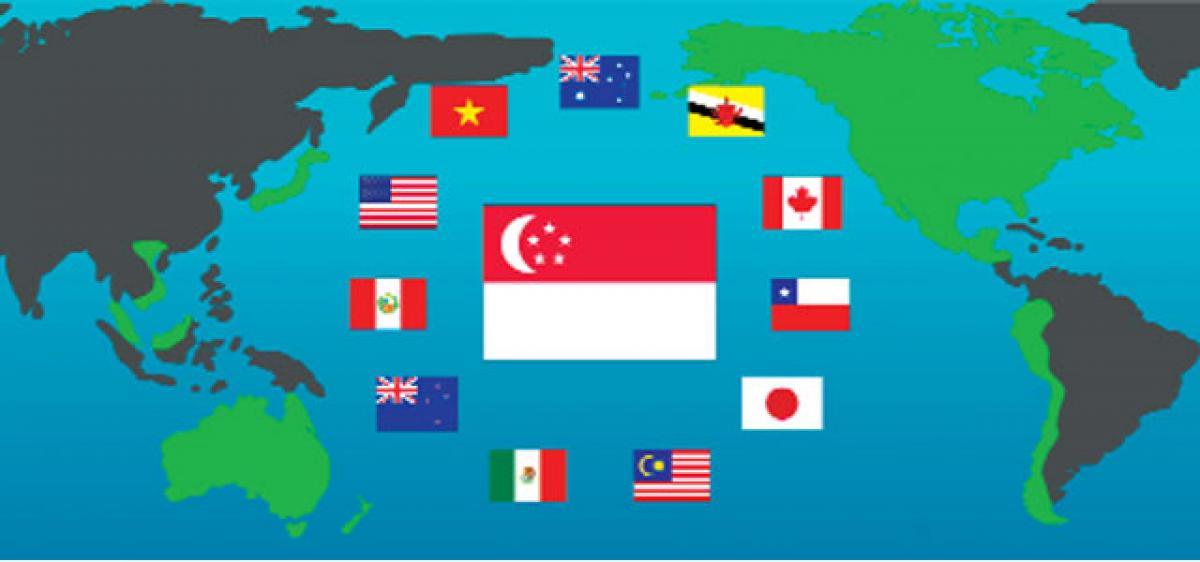US exit from TPP to impact security architecture in Asia-Pacific

US President-elect Donald Trump’s has resolved to undo the Obama administration’s recalibration of Asia-Pacific strategic equations by pulling out of the Trans Pacific Partnership (TPP) Agreement. The agreement was signed this year after seven years of protracted negotiations between 12 Pacific Rim countries.
US President-elect Donald Trump’s has resolved to undo the Obama administration’s recalibration of Asia-Pacific strategic equations by pulling out of the Trans Pacific Partnership (TPP) Agreement. The agreement was signed this year after seven years of protracted negotiations between 12 Pacific Rim countries.
As expected, Donald Trump officially took the much awaited decision to withdraw the US from 12 -nations Trans-Pacific Partnership (TPP). Donald Trump has been active in making a number of policy changes since he took the charge of the 45th President of the United States.
Background:
With more than five years of negotiation, TPP, one of the most ambitious free trade deals negotiated between developing and developed countries, officially entered into an agreement in February.
Countries have two years to ratify this more than 2,000-pages pact, involving higher labor standards, intellectual property rights, environmental rules and other issues.
None of the 12 countries have completed the ratification process so far. Japan, the second-largest economy after the U.S in this treaty, voted to ratify the deal this month.
The exit of the US from the TPP was one of the most significant decisions taken by Donald Trump. The TPP was signed by his predecessor Barack Obama in 2015. While signing the cancellation of the deal, Trump argued that the TPP deal was harmful to the citizens and manufacturers in America.
He also said that the US is going to stop the ridiculous trade deals that have taken everybody out of our country and taken companies out of our country.
The TPP deal which was negotiated by Barack Obama never got a formal approval from the Congress. But, this deal was supported by business entities. Then, it was considered as the primary economic pillar of Obama administration’s shift towards his own Asia-Pivot Policy meant for Asia pacific region to counter China.
What is TPP?
- TPP stands for Trans-Pacific Partnership. It is a hefty and complex agreement negotiated meticulously by 12 countries: the United States, Mexico, Peru, Canada and Chile in the Americas, and Japan, Vietnam, Australia, Malaysia, Vietnam, Brunei, Singapore, and New Zealand in the Asia-Pacific. All these countries comprise almost 40 percent of the world's gross domestic product.
- The main rationale for the deal for many negotiating members was to re-engage the United States as a trading partner, and balance what were sometimes one-sided trade relationships with China by collectively raising standards.
- A TPP minus the US makes it far less attractive for most members.
What’s good about TPP?
- Those in favour say this trade deal will unleash new economic growth among countries involved.
- It is being said that the TPP has high potential to promote economic growth and improve people’s living standards by facilitating the free cross-border movement of key factors of economic activity, such as goods, people, money, and information. Failure to bring the TPP into force would be a great loss to not only the TPP countries such as Japan and the US but also the global economy they argue.
Why Trump is against this deal?
- Although Trump’s policy statements have been, at best, contradictory, he has been consistent in his opposition to TPP. He thinks such deals will hurt American workers and undercut US companies. His stance on trade is protectionist: he has vowed to shield Americans from the effects of globalised trade by slapping hefty tariffs on cheap Chinese imports of up to 45%.
- Trump says, “The TPP creates a new international commission that makes decisions the American people can’t veto, making it easier for our trading competitors to ship cheap subsidised goods into US markets – while allowing foreign countries to continue putting barriers in front of our exports.”
- However, this pullout could threaten the US’ Asia rebalancing.
Criticisms:
- Those against TPP fear it could mean jobs will move from the US to developing countries. They also do not like the fact the five-year talks were held largely in secret.
- The TPP would also have extensive negative ramifications for users’ freedom of expression, right to privacy and due process, as well as hindering peoples’ abilities to innovate.
- The TPP suffers from a serious lack of transparency, threatens to impose more stringent copyright without public input, and pressures foreign governments to adopt unbalanced laws.
- Some critics also claim that TPP paves the way for companies to sue governments that change policy on, say, health and education to favour state-provided services.
- The TPP will also intensify competition between countries’ labour forces.
How did the idea of the pact come about?
- On the sidelines of Asia-Pacific Economic Cooperation (APEC) meeting in Jeju, South Korea, on June 3, 2003, representatives from Brunei, New Zealand .Chile and Singapore agreed on a Trans-Pacific Strategic Economic Partnership Agreement.
- In January 2008, the US initiated talks with these four countries on trade liberalization in financial service. This move eventually set the stage for the TPP. The Partnership was broadened to include Vietnam, Japan, Australia, Malaysia, Canada, Peru, and Mexico.
Impact of Trump’s decision on India
- The exit of the US from TPP would be beneficial for India as some of its provisions are not in the country's interest. TPP was supposed to re-write the trade rules, most of which were inimical to India's interests.
- India was not part of the TPP, but it has been an important instrument of realpolitik for Washington and New Delhi as they sought to counter the rise of an assertive China without hurting their economic equations with the country.
- In the rebalancing of its resources in Asia-Pacific, the US saw India’s role as the “lynchpin” of the strategy.
- The US’ “Pivot to Asia” and India’s “Act East” policies conflate. Washington sees India as having a greater role in providing security and stability in the region.
- The two strategies have been shaping the security order in the region as India was reinvigorating its ties with Asian powers like Japan and Australia that has rattled China greatly.
- Now, India should not be complacent because of the current uncertainty surrounding TPP. We must fully understand the implications of the various TPP disciplines and how we should strategise ourselves in response to the very many ways they can impact us.
- There is a possibility that the US’s withdrawal from the globalization would create a distinct possibility for China to fill its shoes. The rise of China in this reason can cause some concerns to India. Some experts believe that India should carefully watch the developments on this pact so that India could explore opportunities in all the TPP member countries to boost its trade.
Impact of Trump’s decision on RCEP
There are many common misconceptions about TPP. The biggest misconception is that it is assumed that it is simply a trade agreement when it is actually much more than that. TPP not only does TPP slash tariffs, but it also contains intellectual property obligations, anti-corruption measures, environmental commitments and human rights and child labour conditions. As a consequence, neither India nor China would have been ready to sign on this deal.
RCEP is the proposed Free Trade Agreement (FTA) between 16 Asia-Pacific countries which include India, Japan, China, Australia, New Zealand, South Korea, and the 10-member ASEAN bloc. The proposed FTA, which aims to open up trade in goods and services as well as liberalize investment policies, will cover a market of over three billion people in these countries whose total GDP is more than $17 trillion and account for 40 percent of world trade.
After its withdrawal from the TPP, America’s role would be diminishing in the region. As a result, China will emerge as much more powerful nation now. China has already built several new regional alliances through projects like Maritime Silk Road, One Belt One Road (OBOR), Shanghai Cooperation Organization (SCO) and Asian Infrastructure Investment Bank (AIIB). President Xi Jinping is planning to push hard for another regional alliance called the Regional Comprehensive Economic Partnership (RCEP).
It was originally considered as China’s response to Obama’s TPP. Now, New US president’s cancellation of TPP, TPP has slowed down but RCEP is racing ahead. India is neither a partner in TPP nor in RCEP thus far. But now India will be forced to take a view on RCEP on the basis of its status and interests in the region.
What next?
The text of the agreement has to be signed and then ratified by all 12 signatories. Details of how the deal will be implemented would be argued out in individual countries’ legislatures.
- To take effect, the deal has to be ratified by February 2018 by at least six countries that account for 85% of the group’s economic output. And this means that Japan and the US will need to be on board.
- But Mr Trump’s comments suggest Congress will be directed to clearly reject it – if they get to vote on it at all.
- Some countries, including New Zealand, have suggested some sort of deal may be possible without the US. There has been loose talk of changing some of the conditions to let Mr Trump approve it without losing face. But given the rhetoric coming out of Trump Towers, that looks unlikely.
- The TPP’s two biggest economies are the US and Japan, and if Trump follows through on his promise to withdraw from the pact it would send remaining states scrambling to salvage it.
Conclusion
Following the formal exit of the United States from the Trans- Pacific Partnership (TPP), China is hoping to speed up the galvanization of two regional trade proposals the Free-Trade Agreement of the Asia-Pacific (FTAAP) and the Regional Comprehensive Economic Partnership (RCEP).
Apart from it, several member countries expressed hope that the TPP could be salvaged after the US’s decision left its future in serious jeopardy. Other countries, such as China, may help fill the void left by the U.S.
Members of the Trans-Pacific Partnership (TPP) are seeking to move forward with the trade agreement after the United States withdrew.




















